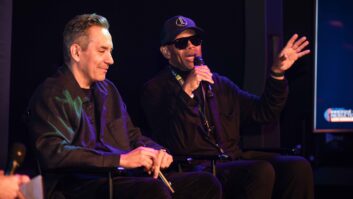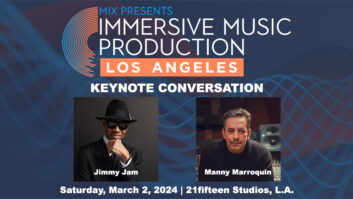
Cambridge, UK (November 22, 2022)—The FIFA World Cup official soundtrack project features three songs recorded at Katara Studios in Doha, Qatar, where dozens of audio converters from Prism Sound are in regular use.
“Katara Studios has over 50 Prism Sound converters ranging from the flagship ADA-8XR multichannel converters, through to DA2 stereo D/A and AD2 stereo A/D converters,” says Mazen Murad, who is Katara Studio’s director of music production and mastering engineer. “We use them for everything, all the time. For the FIFA World Cup project, every activation that had anything to do with music involved a Prism Sound unit at some point in the creative chain, from recording live musicians, through to mixing, mastering and post production.”
The 2023 World Cup, which is currently taking place in Qatar, has seen FIFA break with tradition by scrapping the concept of one official song. Instead, it has released the FIFA World Cup official soundtrack for the opening and closing ceremonies that features multiple songs from artists such as US star Trinidad Cardona, Afrobeats icon Davido, Qatari sensation AISHA, Puerto Rican multiplatinum award-winning superstar Ozuna and French-Congolese rapper Gims.
Producer and His Puppet Adopt Prism
Produced by FIFA’s creative entertainment executive, RedOne, the three songs on the official soundtrack recorded at Katara Studios included “Hayya Hayya” (Better Together), featuring Trinidad Cardona, Davido and AISHA; “Arhbo,” featuring Ozuna, GIMS and RedOne; and “Light the Sky,” featuring four of the Arab world’s most famous female singers: Balqees, Nora Fatehi, Manal and Rahma Riad.
For the project, the studio hosted a week of full orchestral sessions, which were engineered by Matt Howe, Katara’ Studio’s chief recording engineer and formerly of AIR Studio and Metropolis. Howe and Murad invited British-based composer and conductor Youki Yamamoto to lead from the podium. The orchestral sessions used Prism Sound converters to input audio from around 64 microphone signals into Pro Tools.
“Some of Katara’s larger systems are configured with up to 96 channels worth of Prism Sound ADA-8XR’s in transportable racks,” Howe says. “We can even go higher than that if we unite them in tandem with our other interface racks, at mixed sample rates and connected to other capture systems. This is useful when we have requests for very high definition “audiophile” multichannel recordings such as Dolby Atmos and Immersive sound “Stem” capture and delivery when we can afford to go outside of the remit of broadcast standards.”







